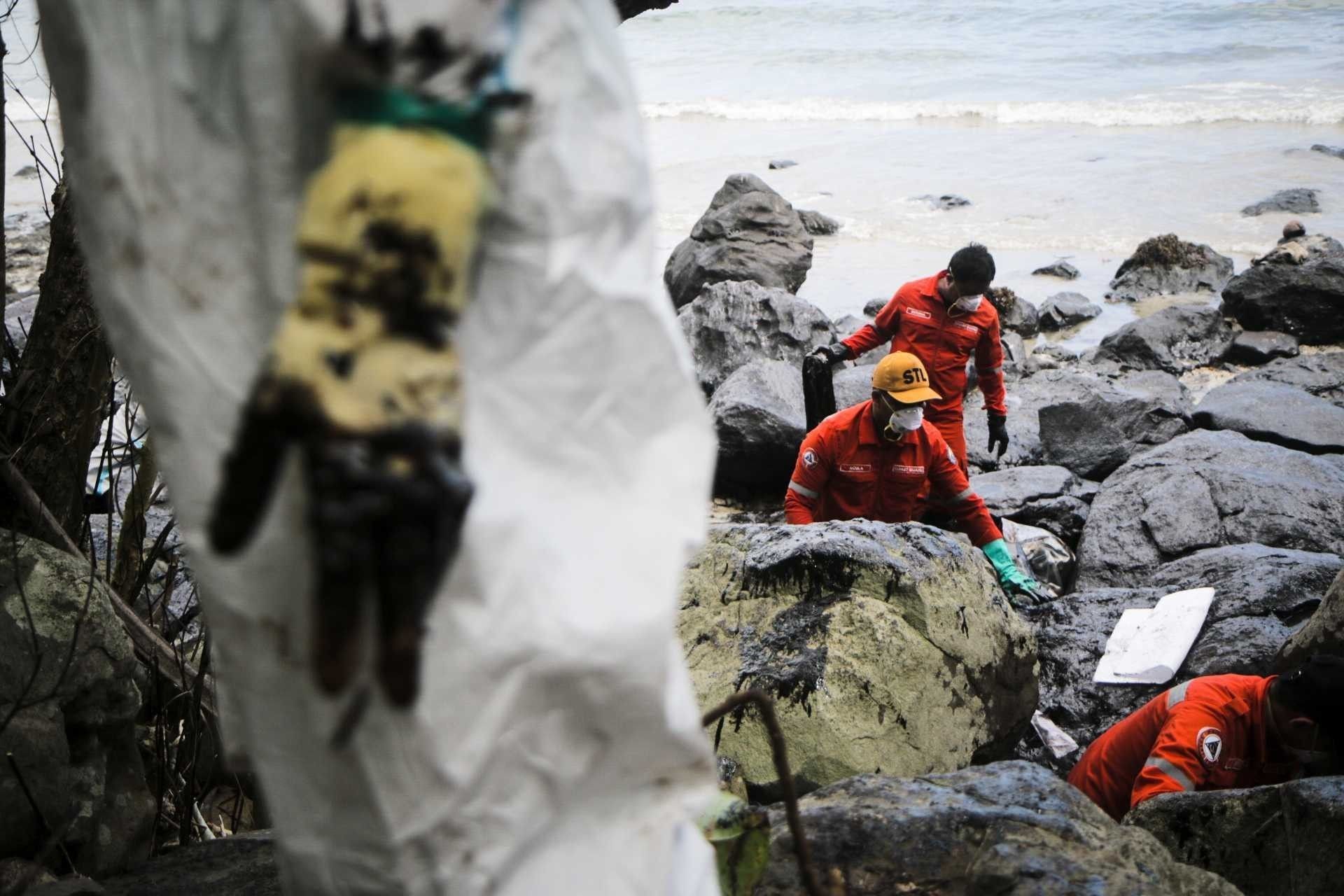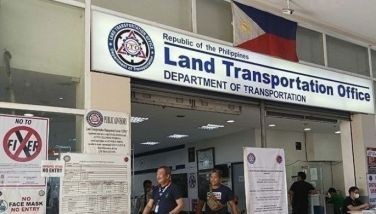Coast Guard expects wider oil spill area

MANILA, Philippines — Authorities will have to contend with a wider oil spill because the MT Princess Empress, which sank in waters off Naujan, Oriental Mindoro, has yet to leak a significant amount of industrial oil in its tank, the Philippine Coast Guard (PCG) revealed yesterday.
“The forecast is that the oil spill will spread wider because, by our estimate, not all of it has really leaked out yet. If it were to be released continuously, that would be big. A lot of oil would spill,” Rear Admiral Armand Balilo, PCG spokesman, said in Filipino.
Balilo said the tanker was loaded with more than 900,000 liters of industrial oil and not 800,000 liters as earlier reported, based on documents gathered from Princess Empress.
Amid the disparity in figures, Balilo said in a radio interview yesterday that the vessel was not overloaded when it sank on Feb. 28. Based on the evaluation, the motor tanker’s weight and capacity did not cause its sinking, he said. ‘Fake CPC?’
Earlier, though, Balilo disclosed that they were conducting an investigation to determine the authenticity of the Certificate of Public Convenience (CPC) granted by the Maritime Industry Authority (MARINA) to the MT Princess Empress due to some irregularities.
Asked if the Princess Empress was seaworthy when it was allowed to sail on Feb. 28, Balilo said the PCG relied on the CPC, a document that should guaranty that the motor tanker passed scrutiny of the MARINA.
“That has always been the presumption,” Balilo, speaking in Filipino, said. “Now if there is one and it’s not authentic, then the Marina says it has no CPC, we have a problem there. That means it did not pass the Marina examination.”
If proven that the Princess Empress falsified the CPC, criminal charges will be filed against the shipping company.
‘It was a scrap ship’
In addition, Justice Secretary Jesus Crispin Remulla revealed yesterday that the owners of MT Princess Empress had “misrepresented” its condition as a brand new vessel before the PCG. Remulla said investigators have sworn information that the sunken vessel is, in fact, a 50-year-old scrap ship that was rebuilt twice to become a motor tanker to transport oil.
“The first claim with Coast Guard, they (ship owners) said it was a two-year-old vessel – brand new, so to speak, by Philippine standards. But actually, it is not new. There was misrepresentation from the beginning of this case,” he said.
“From scrap, it was rebuilt to be an LPG (liquefied petroleum gas) carrier. Then it was rebuilt again to make it long enough to be an oil tanker,” he added.
The information was supplied through an affidavit by a person who had knowledge of the vessel’s history and discussed in the meeting Remulla had with government agencies about legal actions to be taken over the incident.
Case build-up
At present, the National Bureau of Investigation (NBI) is conducting further probe and field interviews to build a case.
Remulla said relevant agencies including the NBI, PCG, Department of Transportation, Bureau of Fisheries and Aquatic Resources, Department of Environment and Natural Resources (DENR) and the Department of Trade and Industry have provided information for the ?investigation and that they are working together for a case build-up.
“We are sorting out the evidence so that we can file the proper complaint, collate all the data but as far as we’re concerned, there are possible cases to be filed… including criminal (complaints),” he said.
“This will be filed by the DOJ legal office and we intend to do this by Tuesday and we hope by then our study is already done… We will go there and validate our findings and look for strategies on how to tackle this,” he added.
The justice chief said he plans to visit the site of the oil spill, which is now being “considered a crime scene.”
Among the liabilities that the owners of the vessel are facing are environmental damage, health risks and damage to biodiversity.
Oil spill response on track Meantime, the oil spill response operation led by the PCG with other government agencies like the DENR and other stakeholders is still ongoing.
Balilo said PCG Southern Tagalog-Batangas personnel are monitoring the Verde Island Passage (VIP) and the sea conditions in preparation of the oil spill reaching the area between Batangas and Mindoro Island.
The University of the Philippines’ Marine Science Institute (UP-MSI) has described the VIP as a body of water with one of the highest concentrations of coastal fish species, corals, crustaceans, mollusks, seagrasses and mangroves.
The PCG official said the Japan Disaster Relief expert team sent by the Japanese government has already examined the site of the oil spill and will be making its recommendations.
In a meeting with Commodore Geronimo Tuvilla, the Japanese experts commended the Philippine government’s efforts in addressing the oil spill as being “correct and on the right track.”
The government is trying to contain the spillage of thick industrial fuel oil seeping out of the vessel which sank 389.1 meters below sea level, 13.89 kilometers northeast of Balingawan Point of Pola, Oriental Mindoro.???‘Slim chance’ of reaching Puerto Galera, but…??Yesterday, Dr. Irene Rodriguez of the UP-MSI warned that if the oil spill is not controlled soon enough, there is a chance – however slim – that the slick could reach as far as the beach resort area of Puerto Galera in Calapan, Oriental Mindoro and other parts of Batangas.
“Based on prevailing wind direction, wind velocity and ocean current, the projection is majority of the oil slick will still go to Naujan and Pola,” said Rodriguez. “But there is a possibility for a fraction of the oil slick to be directed toward the area of Puerto Galera, Calapan and some areas of Batangas.”
For his part, Mayor Rocky Ilagan of Puerto Galera – tagged as the “center of tourism in Oriental Mindoro” – maintained there is a “slim chance” that the oil spill could reach his town.
The marine scientist said that the amihan or northeasterly winds have weakened, which could cause a change in the direction and severity of the oil spill.
As it is, Verde Island Passage, which she said is considered the “center of the center of marine biodiversity” due to presence of endangered marine species, is already under imminent threat.
The weakening of the amihan, though, can be advantageous in the sense that the spreading of the oil can be prevented, said Rodriguez.
However, she stressed that the oil from MT Princess Empress should be controlled “very close to the point source.”
“We have that window of opportunity to clean it right there and then and prevent it from going close to near shore areas and coastal environment where it will be more difficult to handle and clean,” she said.
Interviewed by dzBB radio, Ilagan said that while the possibility of the oil slick reaching Puerto Galera’s beautiful shores is small, the local government is already preparing oil spill booms that would be lent to neighboring towns that might need them.
Rodriguez said the UP-MSI is recommending the use of coconut husks as oil spill booms, instead of human hair because various chemicals from hair and beauty products could pollute the seawater and affect marine life.
P43 million aid dispatched
So far, the government and private groups have provided 43.5 million worth of aid to 74 areas adversely affected by the oil spill in Regions 4-B (Mimaropa) and 6 (Western Visayas), according to the Presidential Communications Office (PCO).??Citing a report received by President Marcos from Senior Undersecretary Carlito Galvez, Jr., officer-in-charge of the Department of National Defense, this assistance came from the Office of Civil Defense, Departments of Health and of Social Welfare and Development, local government units (LGUs) and non-government organizations.
Galvez, who also chairs the National Disaster Risk Reduction and Management Council, reported that the oil spill has affected 31,497 families or 143,713 persons in 122 barangays.
At least 169 individuals were injured or fell ill because of the oil spill, which has also affected the livelihood of 13,654 fisherfolk, the PCO said.
A state of calamity has been declared in the towns of Bansud, Bongabong, Bulalacao, Gloria, Mansalay, Naujan, Pinamalayan, Pola and Roxas in Oriental Mindoro and in Caluya in Antique.
Galvez said 894 sacks of oil-contaminated debris and 77.5 drums of waste for treatment were collected during the government’s shoreline cleanup activities.
A response team with remotely operated vehicle (ROV) is scheduled to arrive on March 20 from Japan to assist in the cleanup efforts. The vehicle was provided by Harbor Star, a private firm contracted by the insurance firm of the shipping company owner.
“The task force managing the oil spill in Mimaropa in collaboration with the LGU of Oriental Mindoro shall coordinate with the Bureau of Customs, Bureau of Immigration and Bureau of Quarantine to expedite the entry of the incoming response team,” the PCO quoted Galvez as saying.
Malayan Salvage and Towing Corp., a private firm also contracted by the insurance firm of the shipping company, supports offshore oil containment, it added.
At the same time, the PCG will look for an alternative ROV from a local source to detect and recover the oil spill source.
Marcos has assured oil spill-affected areas of assistance and has directed agencies to intensify their cleanup efforts.
Binay urges swift response
In Congress, Sen. Nancy Binay suggested that the government immediately set up assistance facilities to provide financial assistance to the families affected by the oil spill.
Binay, who chairs the Senate committee on tourism, said the oil spill has already forced local and foreign tourists to cancel their bookings to prime tourist destinations in Oriental Mindoro for the Holy Week.
“The impact of the spillage is already very alarming, and even more worrying because there is a high possibility that it will reach Batangas and Palawan if no organized action is taken,” added Binay, who called for “collective action from both government and non-government groups” to prevent the situation from getting worse.
“What we can do right away is to set into motion the assistance facilities of DSWD and activate the TUPAD program,” said the senator.
TUPAD is the Tulong Panghanapbuhay sa Ating Disadvantaged/ Displaced Workers, a community-based package of assistance that provides emergency employment for displaced workers, underemployed and seasonal workers, for a minimum period of 10 days, but not to exceed a maximum of 30 days, depending on the nature of work to be done.
“We can tap displaced tourism workers, community-based organizations, and those livelihoods were affected to help in the cleanup and in setting up barriers to mitigate the environmental impact and public health risks,” she added.– Neil Jayson Servallos, Alexis Romero, Ghio Ong, Cecille Suerte-Felipe
- Latest
- Trending



























